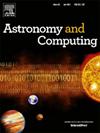Processing of GASKAP-Hi pilot survey data using a commercial supercomputer
IF 1.8
4区 物理与天体物理
Q2 ASTRONOMY & ASTROPHYSICS
引用次数: 0
Abstract
Modern radio telescopes generate large amounts of data, with the next generation Very Large Array (ngVLA) and the Square Kilometre Array (SKA) expected to feed up to 292 GB of visibilities per second to the science data processor (SDP). However, the continued exponential growth in the power of the world’s largest supercomputers suggests that for the foreseeable future there will be sufficient capacity available to provide for astronomers’ needs in processing ‘science ready’ products from the new generation of telescopes, with commercial platforms becoming an option for overflow capacity. The purpose of the current work is to trial the use of commercial high performance computing (HPC) for a large scale processing task in astronomy, in this case processing data from the GASKAP-Hi pilot surveys. We delineate a four-step process which can be followed by other researchers wishing to port an existing workflow from a public facility to a commercial provider. We used the process to provide reference images for an ongoing upgrade to ASKAPSoft (the ASKAP SDP software), and to provide science images for the GASKAP collaboration, using the joint deconvolution capability of WSClean. We document the approach to optimising the pipeline to minimise cost and elapsed time at the commercial provider, and give a resource estimate for processing future full survey data. Finally we document advantages, disadvantages, and lessons learned from the project, which will aid other researchers aiming to use commercial supercomputing for radio astronomy imaging. We found the key advantage to be immediate access and high availability, and the main disadvantage to be the need for improved HPC knowledge to take best advantage of the facility.
利用商用超级计算机处理GASKAP-Hi先导测量数据
现代射电望远镜产生大量数据,下一代甚大阵列(ngVLA)和平方公里阵列(SKA)预计将每秒向科学数据处理器(SDP)提供高达292gb的可见性。然而,世界上最大的超级计算机的能力持续呈指数级增长,这表明在可预见的未来,将有足够的能力来满足天文学家处理新一代望远镜“科学就绪”产品的需求,商业平台将成为产能过剩的一种选择。当前工作的目的是尝试将商用高性能计算(HPC)用于天文学的大规模处理任务,在这种情况下处理来自GASKAP-Hi试点调查的数据。我们描述了一个四步骤的过程,其他研究人员希望将现有的工作流程从公共设施移植到商业提供商,可以遵循这个过程。我们使用该过程为ASKAPSoft (ASKAP SDP软件)的持续升级提供参考图像,并使用wclean的联合反卷积功能为GASKAP合作提供科学图像。我们记录了优化管道的方法,以最大限度地降低商业供应商的成本和消耗时间,并给出了处理未来完整调查数据的资源估计。最后,我们记录了这个项目的优点、缺点和经验教训,这将有助于其他研究人员利用商业超级计算机进行射电天文成像。我们发现关键的优势是即时访问和高可用性,而主要的缺点是需要改进HPC知识才能充分利用该设施。
本文章由计算机程序翻译,如有差异,请以英文原文为准。
求助全文
约1分钟内获得全文
求助全文
来源期刊

Astronomy and Computing
ASTRONOMY & ASTROPHYSICSCOMPUTER SCIENCE,-COMPUTER SCIENCE, INTERDISCIPLINARY APPLICATIONS
CiteScore
4.10
自引率
8.00%
发文量
67
期刊介绍:
Astronomy and Computing is a peer-reviewed journal that focuses on the broad area between astronomy, computer science and information technology. The journal aims to publish the work of scientists and (software) engineers in all aspects of astronomical computing, including the collection, analysis, reduction, visualisation, preservation and dissemination of data, and the development of astronomical software and simulations. The journal covers applications for academic computer science techniques to astronomy, as well as novel applications of information technologies within astronomy.
 求助内容:
求助内容: 应助结果提醒方式:
应助结果提醒方式:


